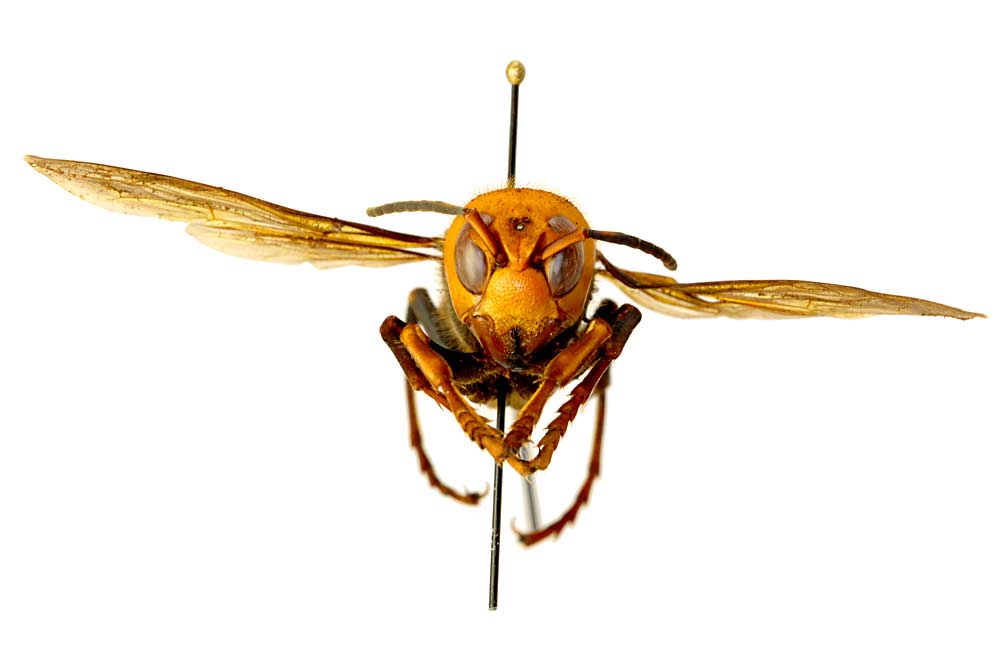
Last fall, beekeeper Teddy McFall went to inspect a hive and found a massacre.
“I noticed all these dead bees in front of the hive that were missing their heads and were all chopped up,” said McFall, who lives in Western Washington’s Whatcom County, near the Canadian border. He’s lost hives to yellow jacket wasps before, but he thought it was very peculiar because there were no dead yellow jackets or other hornets among the carnage. “Usually, a strong hive like that can mount a good defense. That’s why I took pictures, because it was so bizarre,” he said.
A few months later, an announcement from the Washington State Department of Agriculture solved his mysterious massacre: An enormous, invasive hornet that can destroy honey bee hives in “a matter of hours” was found for the first time in the United States just a few miles from the destroyed hive.
Like something out of a horror movie, the 1.5- to 2-inch-long Asian giant hornet (Vespa mandarina) kills bees by decapitating them and then takes the brood so that the hornets can feed it to their own young, according to an alert from the WSDA.
“Unfortunately, these European honey bees have no way of defending themselves against the Asian giant hornet the way Japanese honey bees can,” McFall said. “It’s pretty upsetting.”
Eradicating the hornet will require a concerted effort between state, federal and local officials, informed by international scientists with more experience with the hornet, along with beekeepers and the public, said Karla Salp, public outreach coordinator for the state Department of Agriculture. Many of the details are still being worked out.
“We’ll be doing some trapping in the spring for emerging queens and more extensive trapping in Whatcom County in the summer to try to catch any workers before they go into their slaughter phase in the late summer,” she said. “We want to track the workers back to the nests and eradicate them.”
How many nests may already be present in the region is one of many unknowns. Four reports of the hornet were verified near Bellingham and the Canadian border, but the locations suggest at least two nests, Salp said. Each nest is capable of producing up to 300 new queens. Meanwhile, several findings were made in British Columbia last fall for the first time as well, including a hive that was eradicated on Vancouver Island.
Washington officials were able to learn from the Vancouver experience, and they now know that typical beekeeping attire is not sufficiently protective for the hornet’s long stinger, Salp said. Although not typically aggressive, the hornet packs a powerful venom and long stinger, making it a public health concern as well as a honey bee concern.
The hornet can be distinguished by its size, large orange head with prominent eyes and a black-and-yellow-striped abdomen. They nest in the ground in large colonies, which may be hard to see, but the impact on a hive is obvious: piles of dead, headless bees.
Trapping will be key to the state’s efforts to find and eradicate the pest, Salp said, and she knows beekeepers and many Northwest Washington residents are eager to help and want to put out their own traps. But it’s crucial that anyone trapping for the hornet reports it to the state, she said.
“If they are going into someone else’s traps and we don’t know about them, we might be looking in the wrong place,” Salp said. “We’re going to be depending on the public.”
Exactly how best to trap for these enormous wasps remains to be determined, but Salp said officials plan to share with the public, as soon as possible, the best approaches that minimize harm to native species. Officials also need to figure out how to capture some live hornets, tag them in some fashion, track them back to the colony and eradicate it.
“Partners at the state, federal and international level are working together to put out good information to share with the public that’s accurate, and that takes time,” Salp said.
As for the local beekeepers club, McFall said he and others would be willing to lose hives if that results in tracking and eradicating the Asian giant hornets. There’s not much else that can be done to protect a hive, he added.
For more information or to report if you see one of these formidable hornets, go online at agr.wa.gov/hornets or call 1-800-443-6684. •
—by Kate Prengaman






Leave A Comment